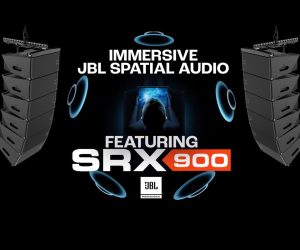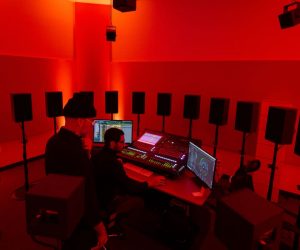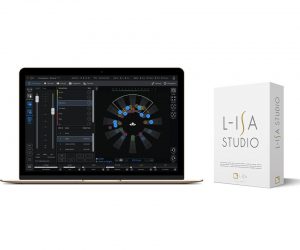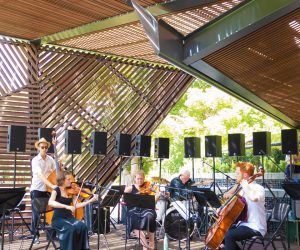
Spatial Audio Goes to the Opera
Gilgamesh is a contemporary opera leveraging the latest in d&b Soundscape spatial audio.
Main Photo: Daniel Boud
Opera is about purity. Opera purists get antsy if you mess with the purity. The operatic ideal is putting performers in an amazing hall and then let ‘er rip – no mics; no loudspeakers; no fancy processing.
But a new generation of opera lover can appreciate an alternative way. Something that allows more wriggle-room for innovation. Not to replace the purity of opera but as another offering.
‘Gilgamesh’ by Sydney Chamber Opera is one such example of contemporary opera being staged with a no-holds-barred approach to innovation.
For starters, Gilgamesh is a new production, written by Aussie, Jack Symonds. It’s got many of the hallmarks of a classic opera – love, heroics, betrayal, intrigue – but with a heady dose of the visceral – both literal and figurative – along with contemporary dance and themes.
Next, the venue is far from traditional. Carriageworks is a performance space in Sydney’s inner west, inside a cavernous heavy industry shed from another era. When you walk into Carriageworks you can’t help but expect the unexpected.
And, finally, the staging and production is modern and innovative. The five vocalists occupy a large white flat-floor stage, with a lighting grid above and the orchestra to one side. The Carriageworks performance space itself has stratospheric ceilings and no real inherent acoustic. It’s much like a film soundstage – big and dead. In other words, without a sound reinforcement solution, there wouldn’t be a show. But what sort of sound system would be most appropriate? The show producers knew just who to ask – Bob Scott.
The goal is to make the opera sound open and realistic, with depth and warmth, but larger than life


INTRO TO SOMETHING DIFFERENT
“I was new to Soundscape but even with my training wheels on and a bit of a cobbled together PA, it was an outstanding success. I was blown away by what Soundscape could do for the Antarctica production.”
When planning for Gilgamesh commenced, Bob Scott was approached by the SCO directors, they were effectively asking Bob to suit up again: “They wanted high-fidelity amplification that’s transparent and believable. The goal is to make the opera sound open and realistic, with depth and warmth, but larger than life.”
EPIC AUDIO
The Gilgamesh audio challenge was different. There would be no Perspex box, for starters, but the audio would need to keep pace with the dynamism of the work – with the performers often flinging themselves around the performance area singing full throttle.
“When we started rehearsals, the space was so large that you couldn’t tell who was singing. We’re using DPA 4000 series headsets plugged into Shure Axient wireless and it sounds astonishingly good – clear and very present. But when you plug a microphone directly into a PA, like we were doing in rehearsals, there’s no connection between the voice and the artist. Then, once we started using Soundscape to track and position the voices, it all clicked. Soundscape makes it believable, with the sound coming from where the singer is, even though it’s amplified.”


EN-SCENE ON THE SCENE
The d&b Soundscape solution uses En-Scene to locate and pan the performers. It’s an object-based system that psychoacoustically places the nominated mono source anywhere in the physical space, thanks to an easy to manipulate UI linked to a 64×64 DS100 matrix/processor.
Gilgamesh audio system engineer, John Hall, stationed behind Bob Scott and his Yamaha Rivage at FOH, manually follows the performers around via two touchscreens. It’s a job that takes considerable focus and concentration over the two-plus hours of show time. But as John describes it, the payoff is when you position the artist in En-Scene smack-dab where their acoustic output (ie. their voice) is emanating. Like a heat-seeking missile locking on to its target, the impact of the combination of ‘locked-on’ acoustic and electroacoustic output is magical. The challenge is to repeat the trick continuously and dynamically for two hours!
It does beg the question: why not use a tracking system, such as BlackTrax, to handle the job automatically? One constraining factor is the costumes. Often there’s nowhere to secure an emitter. The other consideration is having a human to make decisions about placement that aren’t necessarily literal but more conducive to a better result. In this regard, John Hall, with his many years experience in live production, is your man.
THE PA
The d&b loudspeaker design (supplied by Eighth Day Sound) is based on a five-hang Y-Series frontal system, supplemented by seven Y-Series enclosures for frontfill and additional d&b point source loudspeakers for surround spatial placement. “Every speaker has its own amp with d&b Array Processing. It’s amazing how much pattern control that gives you,” explains Bob Scott.
The bulk of Gilgamesh’s Soundscape magic happens thanks to the frontal system. Using d&b En-Scene spatial localisation and the En Space convolution reverb, the performers can be precisely positioned in space ‘behind’ the loudspeakers. The effect is uncanny. At once you’re aware that the performance is amplified because of the power and clarity, but equally the loudspeakers melt away.
Interestingly, the frontfills play a pivotal role in the precise imaging. More than fill, the speakers ranged across the stage ‘front’ give everyone in their coverage pattern a higher-resolution sense of where the performers are panned spatially. Soundscape knows where each loudspeaker is located in the space, to the millimetre, and it leverages its DSP power to ensure each speaker is sent the exact right signal in the time and amplitude domain, along with the En Space reverb component.
“Each speaker has its own independent convolution reverb, which is de-correlated and dependent on the object’s location. It’s the most transparent reverb I’ve ever heard,” enthuses Bob Scott.


BRAVE & EXCITING
The popularity of spatial audio for shows such as Gilgamesh is on the rise and you can easily see why. It helps to make sense of the performance and elevates its immersive qualities. Bob Scott is taking Soundscape with him to the Canberra International Music Festival later in 2024. The roster leans heavily to acoustic ensemble performances, again, allowing Soundscape to shine.
“What Soundscape does for me is, essentially, to make the loudspeakers disappear, which is the ultimate goal in sound design – the audience is simply not aware of the PA. Every time I use Soundscape, the response has been phenomenal. It just sounds incredible, and the experience is so immersive, even in unconventional venues like City Recital Hall in Sydney. What we’re doing is different from traditional opera, but it’s brave and exciting.”
Eighth Day Sound: 8thdaysound.com
NAS (d&b): nas.solutions
Bob Scott: bobscott.com.au
















RESPONSES